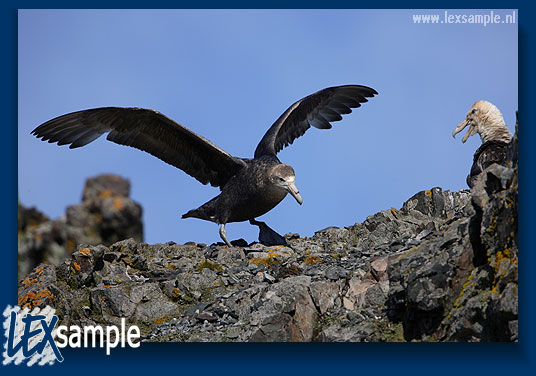LEXsample :: practical information & tips
Guidelines for landings on Antarctica
It is no wonder that people who visit Antarctica are fascinated by the continent's nearly unspoilt environment and the apparently undisturbed nature. This page provides a number of tips that will help to minimize disturbance whilst landing on the continent or one of its islands. Although many rules seems very obvious, they are often forgotten once the visitor's enthusiasm takes over.
Realistically, always expect that you will be disturbing one way or another. By nature, all animals are very cautious and do not like to be approached. Penguins tend to be curious, especially the young, and will approach you after a while if you keep silent and sit still. Other animals can be approached very slowly, but you may not have the time or the opportunity to do so. What's more, elephant seals, shags and giant petrels are very sensitive to distrubance and should be kept at a good distance (some 15m). Use your binoculars to view from close quarters, or a telelens to take a close-up.
 |
| Even though they look impressive, giant petrels are very sensitive to disturbance by humans, especially early in their breeding season. |
Penguins, shags, albatrosses and other seabirds are typically colonial breeders. Antarctica's summer season is only short, and all birds, fur seals and true seals need to breed and rest within that condensed time frame. Therefore it is imperative to keep distubance to the minimum. Always keep in mind that you are just a guest visiting somebody else's busy living room. Conservation of animals and vegetation is more important than your holiday pictures, at all times.
Landings and visiting breeding colonies
- Always follow up instructions of your nature guide
Your nature guide/expedition leader is in charge of your safety as well as the prevention of disturbance to wildlife. The guide knows the sites you are landing, knows where to walk and where access is prohibited, and which distance you should keep between you and the animals. You should always adhere to the IAATO guidelines (summary, 2 pages)
- If the animal responds to you - go back
Whenever you find that an animal reacts to your approach, then you are too close. A screaming tern flying low over your head, a skua diving at you, an elephant seal shifting away from you: they are all trying to tell you that you are too close. Immediately return, walking quietly. It is often possible to get closer if you approach very slow, but you may not have the time. Elephant seals, giant petrels and other breeding birds are very sensitive animals.
- Talk low
Avoid laughing loud, or calling at each other. Especially people walking in groups tend to frequentl forget this.
- Move quietly
Walk in a slow pace, do not wave your arms. Do not start to run (unless it is for your own safety).
- Stay low
If find yourself surrounded by penguins (the birds may group themselves around you), then stay low to the ground; this will avoid scaring the animals off.
- Never walk through paths ('highways')
Penguins follow each other's traces and end up creating highways, a sort of gliding lanes through the snow which allow them to glide fast to the coast. Do not step into these paths. Also, avoid creating holes when stepping onto icy snow, since your deep footsteps make the terrain less accessible for penguins. If you do have to cross a field of ice leaving deep footsteps, then step into the holes created by the other people from your group so the number of holes remains limited.
- Do not step on moss and lichens
If the Antarctic peninsula is greener than the rest of the continent, moss and vegetation grow incredibly slow. So always look ahead where you will put your feet.
By quietly moving around, you can enjoy the silence and the beauty of the landing site. Keep in mind also:
- Which path causes least disturbance? It is hardly possible not to disturb at all, but your impact can be minimized by chosing not to cross areas where many animals have grouped together.
- Be aware of muddy or slippery soil, ensure that you keep a good grip.
- Are there any animals in your direct environment that are resting or hauling out? Watch out behind you - when you have been sitting somewhere for a couple of minutes. a curious penguin may have approached you from behind. Penguins that are lying on the rocks, near bones and stones, can be surprisingly unconspicious. Their feathers or dow may have become dirty with the ground's mud.
- Are there any predators around? Kelp gulls and skuas are always on the look-out to prey on (penguin) chicks that may have become isolated from their parent's protection by your movements. This is especially true in the early season (December, January) when the chicks are still small and easy prey. Later on in the season (February, March) the chicks have grown bigger and gather in creches that give them better protection.
Wildlife photography
There are two additional guidelines for people taking photographs:
- Do not use flash to photograph animals. You can never tell how much stress is caused by a flash, even the animal looks unconcerned, its hearbeat may tell differently.
- Stay low when taking bird photographs (feeding skuas, penguins). When you stand up tall you may scare the birds. What's more, a low viewpoint often gives better photographs.
If you are interested, make sure you also read the photography tips for Antarctica.
© LEXsample 2006

